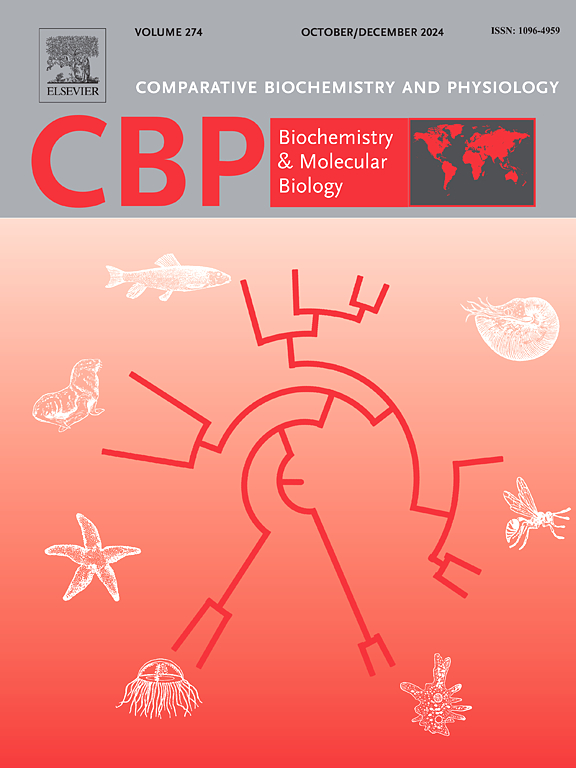Effects of Vibrio alginolyticus on intestinal health and intestinal flora of sea urchin (Strongylocentrotus intermedius)
IF 1.9
3区 生物学
Q4 BIOCHEMISTRY & MOLECULAR BIOLOGY
Comparative Biochemistry and Physiology B-Biochemistry & Molecular Biology
Pub Date : 2025-04-16
DOI:10.1016/j.cbpb.2025.111099
引用次数: 0
Abstract
The aim of this study was to understand the effect of Vibrio alginolyticus on the intestinal tract of Strongylocentrotus intermedius. The effects of injecting V. alginolyticus into the body cavity via the perioral membrane at concentrations of 0 CFU/mL (C), 1.5 × 107 CFU/mL (VA1), and 1.5 × 108 CFU/mL (VA10) on the intestinal tract of S. intermedius were analyzed using histological examination, immunoenzyme activity, and 16S rRNA sequencing. The results showed that V. alginolyticus caused intestinal tissue damage and oxidative stress (e.g. altered levels of superoxide dismutase). In addition, the intestinal flora was altered. At the phylum level, the abundance of Bacteroidota was significantly decreased in the VA10 group, at the genus level, Vibrio spp. exhibited a significant increase following V. alginolyticus injection. Prediction of Kyoto Encyclopedia of Genes and Genomes function in the intestinal flora revealed that high concentrations of V. alginolyticus may have induced pathways such as energy metabolism. These results indicated that V. alginolyticus caused lesions in the intestinal morphology of S. intermedius and disrupted the balance of intestinal flora.

藻溶弧菌对海胆(Strongylocentrotus intermedius)肠道健康和肠道菌群的影响
本研究旨在了解溶藻弧菌对中间圆心弧菌肠道的影响。采用组织学检查、免疫酶活性、16S rRNA测序等方法分析了浓度为0 CFU/mL (C)、1.5 × 107 CFU/mL (VA1)、1.5 × 108 CFU/mL (VA10)的溶藻弧菌经口周膜体腔注射对中间链球菌肠道的影响。结果表明,溶藻弧菌引起肠道组织损伤和氧化应激(如超氧化物歧化酶水平改变)。此外,肠道菌群也发生了改变。在门水平上,VA10组拟杆菌门的丰度显著降低;在属水平上,溶藻弧菌组弧菌门的丰度显著增加。《京都基因与基因组百科全书》对肠道菌群功能的预测表明,高浓度的溶藻弧菌可能具有能量代谢等诱导途径。这些结果表明,溶藻弧菌引起了中间葡萄球菌肠道形态的病变,破坏了肠道菌群的平衡。
本文章由计算机程序翻译,如有差异,请以英文原文为准。
求助全文
约1分钟内获得全文
求助全文
来源期刊
CiteScore
4.60
自引率
4.50%
发文量
77
审稿时长
22 days
期刊介绍:
Comparative Biochemistry & Physiology (CBP) publishes papers in comparative, environmental and evolutionary physiology.
Part B: Biochemical and Molecular Biology (CBPB), focuses on biochemical physiology, primarily bioenergetics/energy metabolism, cell biology, cellular stress responses, enzymology, intermediary metabolism, macromolecular structure and function, gene regulation, evolutionary genetics. Most studies focus on biochemical or molecular analyses that have clear ramifications for physiological processes.

 求助内容:
求助内容: 应助结果提醒方式:
应助结果提醒方式:


